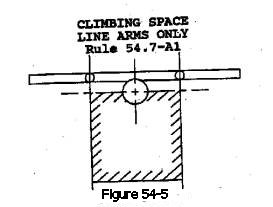
Original Version
Rule 54.7
54.7 Climbing and Working Space
A. Climbing Space
Climbing space shall be maintained from the ground level.
The climbing space shall be maintained in the same position for a distance
of not less than 4 feet vertically both above and below each conductor level
through which it passes. To comply with this requirement the position of
the climbing space shall not be changed through conductor levels which are
less than 4 feet apart. Where the vertical distance between consecutive conductor
levels is 4 feet or more, and less than 8 feet, the position of the climbing
space through such consecutive level may be shifted not more than one-quarter
(90 degrees) of the distance around the pole.
Where a single level of circuitry is installed at the
top of a pole, the climbing space shall extend up to the level of such pole-top
circuitry and need not be provided through and above such level. Where a
conductor is installed at the top of a pole under the provisions of Rule
54.4-D8, the climbing space shall extend up to the level of such pole-top
conductor but need not be provided through and above such level.
This rule is not applicable to non-climbable poles.
See Rule 22.0-D for definition.
Climbing space measured from centerline of pole shall be provided on one side or in one quadrant of all poles or structures with dimensions as specified in the following:
|
|
Rules |
| Wood Crossarm Construction |
54.7-A 1 & 2 |
| Without Wood Crossarms (More than 750 Volts) |
54.11-F |
| Low Voltage Rack Construction |
54.9-F |
| Low Voltage Multiconductor Cable w/Bare Neutral |
54.10-F |
| Poles Jointly Used. |
84.7 & 93 |
| Allowable Obstructions of These Climbing Spaces |
54.7-A3 54.9-F 54.11-G 84.7-E |
The climbing space required by this rule
may be shifted laterally not more than 5 inches on the condition that the
midpoint of the side of the climbing space coinciding with the center line
of the pole shall not be more than 5 inches from the center line of the pole.
The dimensions specified in the above
rules may be reduced not more than 2% because of line angles and minor field
variations.
(1) Dimensions Where Line Arms Only Are Involved: The climbing space where line arms without related buck arms are involved on poles or structures shall be on one side or face of the pole, with the center line of pole approximately midway on one side of the climbing space (See Figure 54-5), and shall have the following dimensions:
| Voltage of. Conductors |
Dimensions of Square |
| 0-7,500 Volts |
30 inches |
| 7,500-46,000 Volts |
36 inches |
| More than 46,000 Volts |
36 inches plus 1/2" per kV in excess of 46kV |

(2)
Dimensions Where buck
Arms Are Involved: The climbing space where line arms and related buck arms
are involved on poles or structures shall be on one side or face of the pole,
or in a quadrant as defined below:
a)
Where the
Vertical Clearance Between Conductors on Line and Buck Arms is Four Feet
or More: The climbing space shall be provided on one side or face of the
pole for each arm as specified in Rule 54.7-Al.
b) Where the Vertical Clearance Between Conductors on Line and Buck Arms is Less Than Four Feet: The climbing-space shall be provided through such levels and located in a quadrant and shall have at least the following dimensions (See Figure 54-6).
| Voltage of Conductors |
Dimensions of Square |
| 0-7,500 Volts |
30 inches |
| 7.500-35,000 Volts |
42 inches |
For circuitry located at pole top, the climbing space specified in Rule
54.7-A1 may be applied to the lower arm and up to but not through the conductors
on the top arm (See Fig. 54-7).

c)
For Combination Arm Construction with Line Arm and Buck Arms or Service
Buck Arm (see Rule 54.8-E for requirements where service drops are involved):
Where the vertical separation between conductor levels on line and buck
arms is 4 feet or more, the climbing space shall be provided on one side
or face of the pole for each level as specified in Rule 54.7-A1.
Where the vertical separation between conductor levels on line and buck
arms is less than 4 feet such separation shall not be less than 2 feet, and
the climbing space shall not be less than prescribed in Rule 54.7-A2b and
the dimensions shall be in accordance with the highest voltage adjacent to
the climbing quadrant (See Figure 54-8).
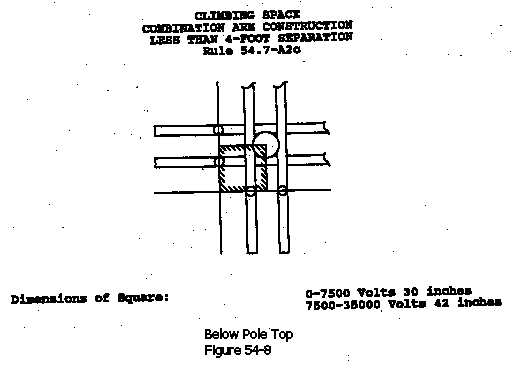
Below Pole Top
FIGURE 54-8
(3)
Allowable Climbing Space Obstructions: Crossarms and their supporting members are allowed in
climbing spaces. Insulators and their attaching
brackets which support line conductors may extend not more than one-half of
their diameter into the climbing space.
Suitably protected vertical conductors attached to the
surfaces of poles, and guys, (except those guys contacting metal pins or
dead-end hardware as specified in Rule 52.7-D) are allowed in climbing spaces provided that not
more than two guys (provided they are separated at the pole by a vertical
distance of not more than 18 inches) and one vertical riser, run, or ground wire
are installed in any 4-foot vertical section of climbing space.
Bolts bonded to or used for the attachment of dead-end
hardware of a circuit of any voltage in horizontal (wood crossarm) configuration
may project into the climbing space provided they are covered with
non-conducting material as specified in Rule
22.2-C.
If such bolts are bonded, a positive
electrical contact shall be made.
The covering of bolts required by this rule shall not apply
to:
a) Bolts associated with circuits of 0 to 750 volts at any level on pole or structure.
b) Bolts associated with circuits of more than 7500 volts when located at the top level of a pole.
c) Bolts associated with brackets and non–wood crossarms.
Modifications of these requirements are specified in: Rule 54.9-F for rack construction; for switches in Rule 58.3-A3 for switches: and Rule 54.11-G for climbing space without wood crossarms.
B. Working Space
Working spaces, unobstructed by conductors or other equipment except as
provided in Rule 54.7-82, of the dimensions as specified in Rule 54.7-81,
shall be provided between supply conductor levels on all poles and in such
positions that the working spaces include the climbing space.
(1)
Dimensions of Working Space:
a) The vertical dimensions of working space above
and below supply conductor levels energized above 750 volts shall be equal
to the entire vertical distance between the supply conductors involved (e.g.
the entire vertical distance between a 750 -20,000 volt level and a 0-750
volt level).
b) When there is no supply conductor level below a
conductor level that is energized above 750 volts, the vertical dimension
of working space shall be 6 feet.
c) The vertical dimension of working space between
supply conductor levels of 0-750 volts shall be equal to the vertical distance
between such levels.
d) The width of the working space where wood crossarms
are involved shall extend from the climbing space to the outmost conductor
position on the crossarm involved. The depth of the working space shall have
the same dimension as the climbing space. This dimension shall be measured
horizontally from the centerline of pole on the climbing side of pole. (See
Figures 54-q A, B and C.)
e) The width of the working space of supply circuits
above 750 volts where wood crossarms are not involved (e.g., vertical and
triangular construction without wood crossarms) shall extend from the climbing
space to the outmost conductor position on the conductor support involved.
The depth of the working space shall have the same dimension as the climbing
space and shall be measured from the centerline of pole (See Figure 54-9D
and 54-9H). When conductors above 750 volts are located on one side of the
pole only (e.g., vertical construction), the dimensions of working space
shall be applied as illustrated in Figures 54-9E and 54-9F (dimension "A"
is equal to the distance from the climbing space to the outmost conductor
position). When climbing space is located in a quadrant, working space shall
be applied as illustrated in Figure 54-9G.
f) The width and depth of the working space for supply
circuits of 0-750 volts where wood crossarms are not involved shall be the
same width and depth as the climbing space.
(2) Allowable Working Space Obstructions:
a) Taps from conductors on line arms or other supports,
extending to conductors on related buck arms or other supports, may pass
through the working space between such levels of conductors.
b) Service drops of 0-750 volts may pass through the
working space of conductors supported on the same crossarm with the drop
conductors and may pass through working space of 750-7,500 volt conductors
provided not less than the clearance between service drop and line conductors
specified in Rule 54.8-C6 are maintained.
c) Cutouts, disconnects, switches and their leads
may be installed in the working space (but not in the climbing space).
d) Lead wires to transformers, capacitors, oil switches,
vacuum switches, and other similar apparatus may pass through the working
space adjacent to the line conductors to which such leads are attached.
e) Terminal fittings of risers and runs, and their
taps, may extend into the working space provided these fittings are the only
obstruction of the working space at their level on the same side of the climbing
space.
f) Street lights and their associated hardware
may extend into the working space.
.jpg)
Strikeout and Underline Version
Rule 54.7
54.7 Climbing and Working Space
This rule is not applicable to non-climbable poles. See Rule 22.0-D for
definition.
Climbing space shall be maintained from the around level. Climbing space, measured from center line of pole, shall be provided on one side or in one quadrant of all poles or structures with dimensions as specified in the following:
|
|
Rules |
| Wood Crossarm Construction |
54.7-A1 & A2 |
| Without Wood Crossarms (Vertical and Triangular Construction) |
54.11-F |
| Low Voltage Rack Construction |
54.9-F |
| Low Voltage Extended Rack Construction |
54.12-F |
| Low Voltage Multiconductor Cable |
54.10-F |
| Poles Jointly Used |
84.7 & 93 |
| Allowable Obstructions of These Climbing Spaces |
54.7-A3 54.9-F 54.12-F3 54.10-F3 54.11-G 84.7-E |
| Working Space (All Types of Construction) |
54.7-B |
The dimensions specified in the above rules may be reduced not more than
2% because of line angles and minor field variations.
The climbing space required by this rule Rules 54.7-A and 54.11-F may be
shifted laterally not more than 5 inches. on the condition that
However, the midpoint of the side of the climbing space coinciding with
the center line of the pole shall not be more than 5 inches from the center
line of the pole, and the minimum distance of any unprotected conductor (or
other energized unprotected part) from canter line of pole shall be maintained
(See Table 1. Case 8).
A. Climbing Space (Wood Crossarm Construction)
Climbing space shall be maintained from the ground level.
The climbing space shall be maintained in the same position for a distance
of not less than 4 feet vertically both above and below each conductor level
through which it passes. To comply with this requirement the position of
the climbing space shall not be changed through conductor levels which are
less than 4 feet apart. Where the vertical distance between consecutive conductor
levels is 4 feet or more, and less than 8 feet, the position of the climbing
space through such consecutive level may be shifted not more than one-quarter
(90 degrees) of the distance around the pole.
Where a single level of circuitry is installed at the top of a pole, the
climbing space shall extend up to the level of such pole-top circuitry and
need not be provided through and above such level. Where a conductor is installed
at the top of a pole under the provisions of Rule 54.4-DB, the climbing space
shall extend up to the level of such pole-top conductor but need not be provided
through and above such level.
(1) Dimensions Where Line Arms Only Are Involved: The climbing space where line arms without related buck arms are involved on poles or structures shall be on one side or face of the pole, with the center line of pole approximately midway on one side of the climbing space (See Figure 54-5), and shall have the following dimensions:
| Voltage of. Conductors |
Dimensions of Square |
| 0-7,500 Volts |
30 inches |
| 7,500-46,000 Volts |
36 inches |
| More than 46,000 Volts |
36 inches plus 1/2" per kV in excess of 46kV |

(2)
Dimensions Where buck Arms Are Involved: The climbing space where line
arms and related buck arms are involved on poles or structures shall be on
one side or face of the pole, or in a quadrant as defined below:
a)
Where the Vertical Clearance Between Conductors on Line and Buck Arms
is Four Feet or More: The climbing space shall be provided on one side or
face of the pole for each arm as specified in Rule 54.7-Al.
b)
Where the Vertical Clearance Between Conductors on Line and Buck Arms
is Less Than Four Feet: The climbing space shall be provided through such
levels and located in a quadrant and shall have at least the following dimensions
(See Figure 54-6).
| Voltage of Conductors |
Dimensions of Square |
| 0-7,500 Volts |
30 inches |
| 7.500-35,000 Volts |
42 inches |
For circuitry located at pole top, the climbing space specified in Rule 54.7-Al may be applied to the lower arm and up to but not through the conductors on the top arm (See Fig. 54-7).

c)
For Combination Arm Construction with Line Arm and Buck Arms or Service
Buck Arm (see Rule 54.8-E for requirements where service drops are involved):
Where the vertical separation between conductor levels on line and buck
arms is 4 feet or more, the climbing space shall be provided on one side
or face of the pole for each level as specified in Rule 54.7-A1.
Where the vertical separation between conductor levels on line and buck
arms is less than 4 feet such separation shall not be less than 2 feet, and
the climbing space shall no be less than prescribed in Rule 54.7-A2b and
the dimensions shall be in accordance with the highest voltage adjacent to
the climbing quadrant (See Figure 54-8).
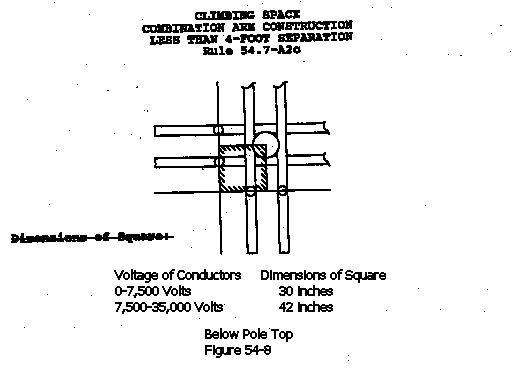
(3)
Allowable Climbing Space Obstructions: Allowable climbing space obstructions
are:
a) Crossarms and their supporting members are allowed in climbing
space.
b)
Insulators and their attaching brackets which support line conductors
may extend not more than one-half of their diameter into the climbing space.
c)
Conductors may extend one-half of their diameter into the climbing space.
d)
Suitably protected (covered only by wood see Rule 22.2):
1) Vertical risers: or
2) Vertical runs; or
3) Ground wires.
Such risers, runs, and grounds are allowable provided that not more than
one is installed in any 4-foot section of climbing space. Conductors
attached to the surface of the poles, and guys
e)
Guys (except those guys metallically contacting metal pins
of or deadend hardware as specified in Rule 52.7-D). However
not more than two guys having a vertical separation of 18 inches or less
can be installed in any 4-foot section of climbing Space.
are allowed in climbing spaces provided that not more than two guys (provided
they are separated at the pole by a vertical distance of not more than 18
inches), and one vertical riser, run, or ground wire are installed in any
4-foot vertical section of climbing space.
f)
Street light brackets may extend one-half their diameter into climbing
space. Associated street 1ight bracket struts are allowed in climbing
Space.
g)
Operating rods (e.g. switch rods) may extend one-half their diameter
into climbing space.
h)
Bands limited to 6 inches in width with no more than one band allowed
in any 24-inch section of climbing space (these limitations are excluded for
pole stubbing and pole splicing bands when pole step provisions are installed).
i)
Bolts and their washers. However, bolts bonded to or used
for the attachment of deadend hardware of circuits above 750 volts
a circuit of any voltage in horizontal (
wood crossarm ) configuration may that
project into the climbing space provided they are shall
be covered with a non-conducting material as specified in Rule
22.2-C. If such bolts are bonded, a positive electrical contact shall be
made.
Exceptions:
The covering of bolts required by this rule shall not apply
to:
a)
Bolts associated with circuits of 0 to 750 volts at any level on pole
or structure.
b1)
Bolts associated with circuits of more than 7500 volts
when located at the top level of a pole.
c2)
Bolts associated with brackets and non-wood
crossarms.
Modification of these requirements in Rule 54,7-A3 are specified
in: Rule 54.9-F for rack construction; Rule 54.10-F3
for multiconductor cable with bare neutral construction; Rule 54.11-G
for triangular and vertical construction climbing space
without wood crossarms; Rule 54.12-F3 for extended rack construction;
and Rule 58.3-A3 for switches.
B. Working Space (All Types of Construction)
Working spaces, unobstructed by conductors or other equipment except as provided in Rule 54.7-B2, of the dimensions as specified in Rule 54.7-B1, shall be provided between supply conductor levels on all poles and in such positions that the working spaces include the climbing space.
(1) Dimensions of Working Spaces
a) The vertical dimensions of working space above and
below supply conductor levels energized above 750 volts shall be equal to
the entire vertical distance between the supply conductors involved (e.g.
the entire vertical distance between a 750 -20,000 volt level and a 0-750
volt level).
b) When there is no supply conductor level below a conductor
level that is energized above 750 volts, the vertical dimension of working
space shall be 6 feet.
c) The vertical dimension of working space between supply
conductor levels of 0-750 volts shall be equal to the vertical distance between
such levels.
d) The width of the working space where wood crossarms
are involved shall extend from the climbing space to the outmost conductor
position on the crossarm involved. The depth of the working space shall have
the same dimension as the climbing space. This dimension shall be measured
horizontally from the centerline of pole on the climbing side of pole. (See
Figures 54-q A, B and C.)
e) The width of the working space of supply circuits above
750 volts where wood crossarms are not involved (e.g., vertical and triangular
construction without wood crossarms) shall extend from the climbing space
to the outmost conductor position on the conductor support involved. The
depth of the working space shall have the same dimension as the climbing
space and shall be measured from the centerline of pole (See Figure 54-9D
and 54-9H). When conductors above 750 volts are located on one side of the
pole only (e.g., vertical construction), the dimensions of working space
shall be applied as illustrated in Figures 54-9E and 54-9F (dimension "A"
is equal to the distance from the climbing space to the outmost conductor
position). When climbing space is located in a quadrant, working space shall
be applied as illustrated in Figure 54-9G.
f) The width and depth of the working space for supply
circuits of 0-750 volts where wood crossarms are not involved shall be the
same width and depth as the climbing space.
(2) Allowable working Space Obstructions:
a) Taps from conductors on line arms or other supports,
extending to conductors on related buck arms or other supports, may pass
through the working space between such levels of conductors.
b) Service drops of 0-750 volts may pass through the working
space of conductors supported on the same crossarm with the drop conductors
and may pass through working space of 750-7,500 volt conductors provided
not less than the clearance between service drop and line conductors specified
in Rule 54.8-C6 are maintained.
c) Cutouts, disconnects, switches, lightning arresters
and their leads may be installed in the working space (but not in the climbing
space).
d) Lead wires to transformers, capacitors, oil switches,
vacuum switches, and other similar apparatus may pass through the working
space adjacent to the line conductors to which such leads are attached.
e) Terminal fittings of risers and runs, and their taps,
may extend into the working space provided these fittings are the only obstruction
of the working space at their level on the same side of the climbing space.
f) Street lights and their associated hardware may extend
into the working space.
.jpg)
Final Version
Rule 54.7
54.7 Climbing and Working Space
This rule is not applicable to non-climbable poles. See Rule 22.0-D for
definition.
Climbing space shall be maintained from the around level. Climbing space, measured from center line of pole, shall be provided on one side or in one quadrant of all poles or structures with dimensions as specified in the following:
|
|
Rules |
| Wood Crossarm Construction |
|
| Without Wood Crossarms (Vertical and Triangular Construction) |
|
| Low Voltage Rack Construction |
|
| Low Voltage Extended Rack Construction |
|
| Low Voltage Multiconductor Cable With Bare – Neutral Construction |
|
| Poles Jointly Used |
|
| Allowable Obstructions of These Climbing Spaces |
|
| Working Space (All Types of Construction) |
The dimensions specified in the above rules may be reduced not more than 2%
because of line angles and minor field variations.
The climbing space required by Rules 54.7-A and 54-.11-F may be shifted laterally
not more than 5 inches. However, the midpoint of the side of the climbing
space coinciding with the center line of the pole shall not be more than
5 inches from the center line of the pole, and the minimum distance of any
unprotected conductor (or other energized unprotected part) from canter line
of pole shall be maintained (See Table 1. Case 8).
A. Climbing Space (Wood Crossarm Construction)
The climbing space shall be maintained in the same position for a distance
of not less than 4 feet vertically both above and below each conductor level
through which it passes. To comply with this requirement the position of the
climbing space shall not be changed through conductor levels which are less
than 4 feet apart. Where the vertical distance between consecutive conductor
levels is 4 feet or more, and less than 8 feet, the position of the climbing
space through such consecutive level may be shifted not more than one-quarter
(90 degrees) of the distance around the pole.
Where a single level of circuitry is installed at the top of a pole, the
climbing space shall extend up to the level of such pole-top circuitry and
need not be provided through and above such level. Where a conductor is installed
at the top of a pole under the provisions of Rule 54.4-D8, the climbing space
shall extend up to the level of such pole-top conductor but need not be provided
through and above such level.
(1)
Dimensions Where Line Arms Only Are Involved: The climbing space where
line arms without related buck arms are involved on poles or structures shall
be on one side or face of the pole, with the center line of pole approximately
midway on one side of the climbing space (See Figure 54-5), and shall have
the following dimensions:
| Voltage of. Conductors |
Dimensions of Square |
| 0-7,500 Volts |
30 inches |
| 7,500-46,000 Volts |
36 inches |
| More than 46,000 Volts |
36 inches plus 1/2" per kV in excess of 46kV |
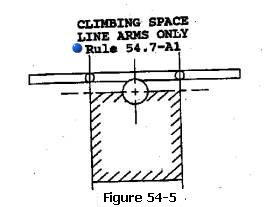
(2)
Dimensions Where buck Arms Are Involved: The climbing space where line
arms and related buck arms are involved on poles or structures shall be on
one side or face of the pole, or in a quadrant as defined below:
a)
Where the Vertical Clearance Between Conductors on Line and Buck Arms
is Four Feet or More: The climbing space shall be provided on one side or
face of the pole for each arm as specified in Rule 54.7-A1.
b)
Where the Vertical Clearance Between Conductors on Line and Buck Arms
is Less Than Four Feet: The climbing space shall be provided through such
levels and located in a quadrant and shall have at least the following dimensions
(See Figure 54-6).
| Voltage of Conductors |
Dimensions of Square |
| 0-7,500 Volts |
30 inches |
| 7.500-35,000 Volts |
42 inches |
For circuitry located at pole top, the climbing space specified in Rule 54.7-A1 may be applied to the lower arm and up to but not through the conductors
on the top arm (See Fig. 54-7).
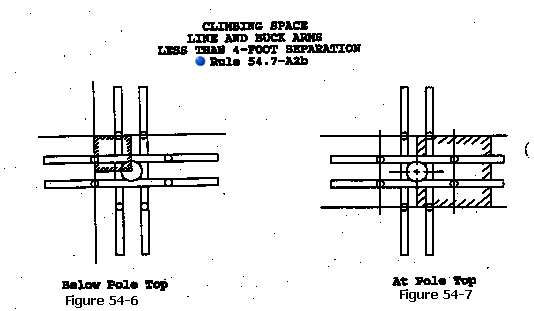
c)
For Combination Arm Construction with Line Arm and Buck Arms or Service
Buck Arm (see Rule 54.8-E for requirements where service drops are involved):
Where the vertical separation between conductor levels on line and buck
arms is 4 feet or more, the climbing space shall be provided on one side
or face of the pole for each level as specified in Rule 54.7-A1.
Where the vertical separation between conductor levels on line and buck
arms is less than 4 feet such separation shall not be less than 2 feet, and
the climbing space shall no be less than prescribed in Rule 54.7-A2b and
the dimensions shall be in accordance with the highest voltage adjacent to
the climbing quadrant (See Figure 54-8).
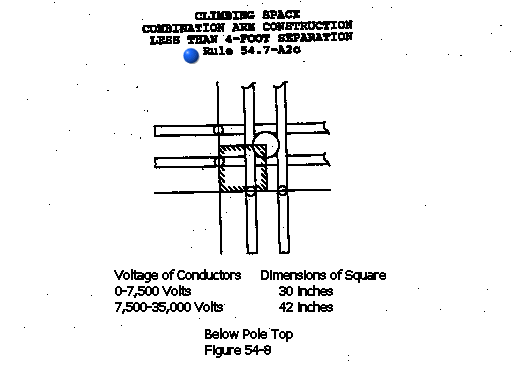
(3)
Allowable Climbing Space Obstructions: Allowable climbing space obstructions
are:
a)
Crossarms and their supporting members.
b)
Insulators and their attaching brackets which support line conductors
may extend not more than one-half of their diameter into the climbing space.
c)
Conductors may extend one-half of their diameter into the climbing space.
d)
Suitably protected (covered only by wood see Rule 22.2):
1) Vertical risers: or
2) Vertical runs; or
3) Ground wires.
Such risers, runs, and grounds are allowable provided that not more than
one is installed in any 4-foot section of climbing space.
e)
Guys (except those guys metallically contacting metal pins of or deadend
hardware as specified in Rule 52.7-D). However not more than two guys having
a vertical separation of 18 inches or less can be installed in any 4-foot
section of climbing Space.
f)
Street light brackets may extend one-half their diameter into climbing
space. Associated street light bracket struts are allowed in climbing
Space.
g)
Operating rods (e.g. switch rods) may extend one-half their diameter
into climbing space.
h)
Bands limited to 6 inches in width with no more than one band allowed
in any 24-inch section of climbing space (these limitations are excluded for
pole stubbing and pole splicing bands when pole step provisions are installed).
i)
Bolts and their washers. However, bolts bonded to or used for the attachment
of deadend hardware of circuits above 750 volts in wood crossarm configuration
that project into the climbing space shall be covered with a non-conducting
material as specified in Rule 22.2-C. If such bolts are bonded, a positive
electrical contact shall be made.
Exceptions:
The covering of bolts required by this rule shall not apply
to:
1)
Bolts associated with circuits of more than 7500 volts when located at
the top level of a pole.
2)
Bolts associated with brackets and non-wood crossarms.
Modification of these requirements in Rule 54.7-A3 are specified in: Rule 54.9-F for rack construction; Rule 54.10-F3 for multiconductor
cable with bare neutral construction; Rule 54.11-G for triangular and vertical
construction without wood crossarms; Rule 54.12-F3 for extended rack construction;
and Rule 58.3-A3 for switches.
B. Woking Space (All Types of Construction)
Working spaces, unobstructed by conductors or other equipment except as
provided in Rule 54.7-B2, of the dimensions as specified in Rule 54.7-B1,
shall be provided between supply conductor levels on all poles and in such
positions that the working spaces include the climbing space.
(1)
Dimensions of Working Spaces
a) The vertical dimensions of working space above and
below supply conductor levels energized above 750 volts shall be equal to
the entire vertical distance between the supply conductors involved (e.g.
the entire vertical distance between a 750 -20,000 volt level and a 0-750
volt level).
b) When there is no supply conductor level below a conductor
level that is energized above 750 volts, the vertical dimension of working
space shall be 6 feet.
c) The vertical dimension of working space between supply
conductor levels of 0-750 volts shall be equal to the vertical distance between
such levels.
d) The width of the working space where wood crossarms
are involved shall extend from the climbing space to the outmost conductor
position on the crossarm involved. The depth of the working space shall have
the same dimension as the climbing space. This dimension shall be measured
horizontally from the centerline of pole on the climbing side of pole. (See
Figures 54-9 A, B and C.)
e) The width of the working space of supply circuits above
750 volts where wood crossarms are not involved (e.g., vertical and triangular
construction without wood crossarms) shall extend from the climbing space
to the outmost conductor position on the conductor support involved. The
depth of the working space shall have the same dimension as the climbing
space and shall be measured from the centerline of pole (See Figure 54-9D
and 54-9H). When conductors above 750 volts are located on one side of the
pole only (e.g., vertical construction), the dimensions of working space
shall be applied as illustrated in Figures 54-9E and 54-9F (dimension "A"
is equal to the distance from the climbing space to the outmost conductor
position). When climbing space is located in a quadrant, working space shall
be applied as illustrated in Figure 54-9G.
f) The width and depth of the working space for supply
circuits of 0-750 volts where wood crossarms are not involved shall be the
same width and depth as the climbing space.
(2)
Allowable working Space Obstructions:
a) Taps from conductors on line arms or other supports,
extending to conductors on related buck arms or other supports, may pass
through the working space between such levels of conductors.
b) Service drops of 0-750 volts may pass through the working
space of conductors supported on the same crossarm with the drop conductors
and may pass through working space of 750-7,500 volt conductors provided
not less than the clearance between service drop and line conductors specified
in Rule 54.8-C6 are maintained.
c) Cutouts, disconnects, switches. lightning arresters
and their leads may be installed in the working space (but not in the climbing
space).
d) Lead wires to transformers, capacitors, oil switches,
vacuum switches, and other similar apparatus may pass through the working
space adjacent to the line conductors to which such leads are attached.
e) Terminal fittings of risers and runs, and their taps,
may extend into the working space provided these fittings are the only obstruction
of the working space at their level on the same side of the climbing space.
f) Street lights and their associated hardware may extend
into the working space.
.jpg)